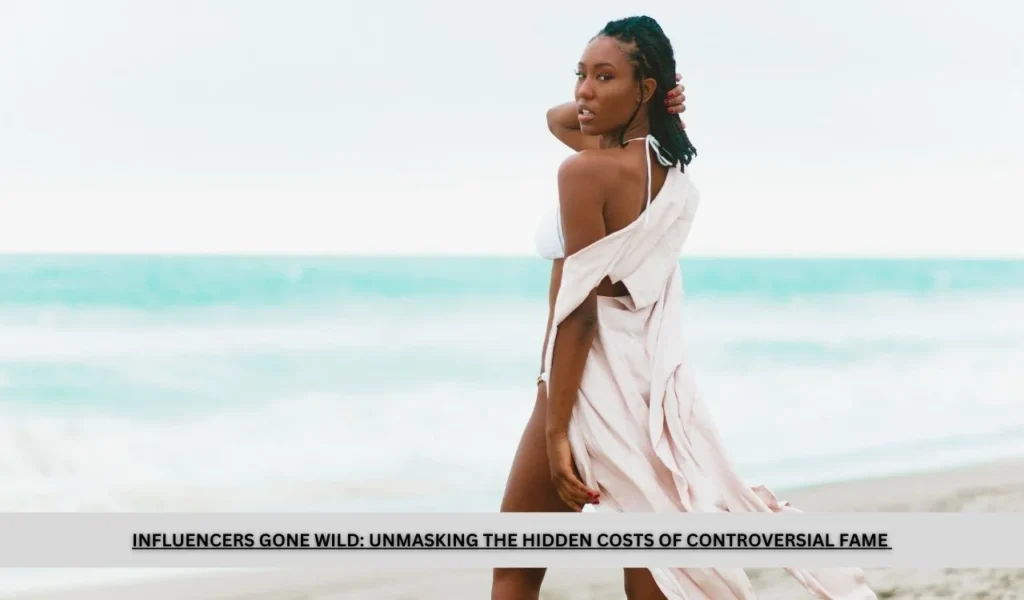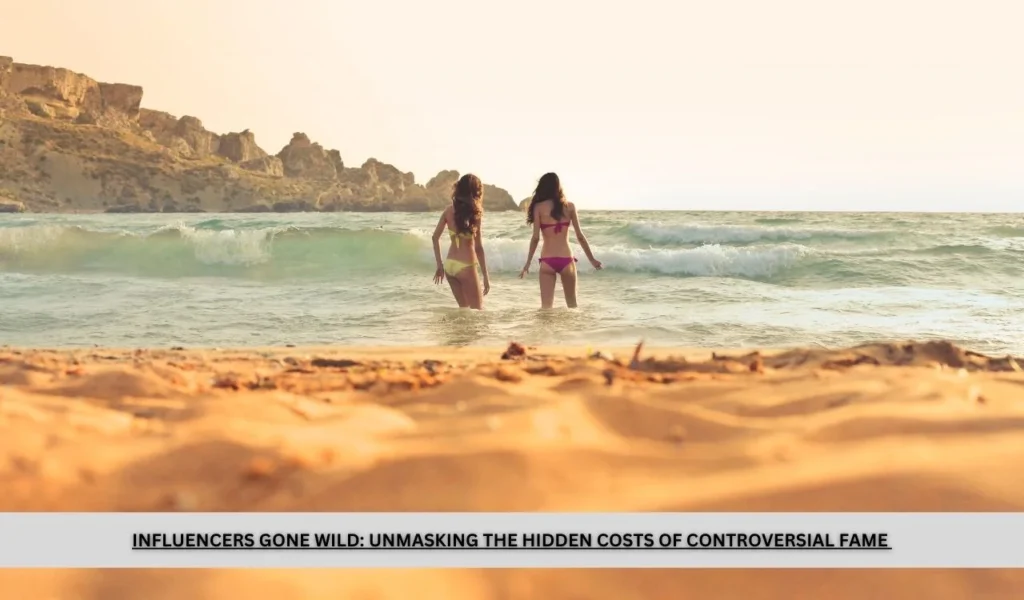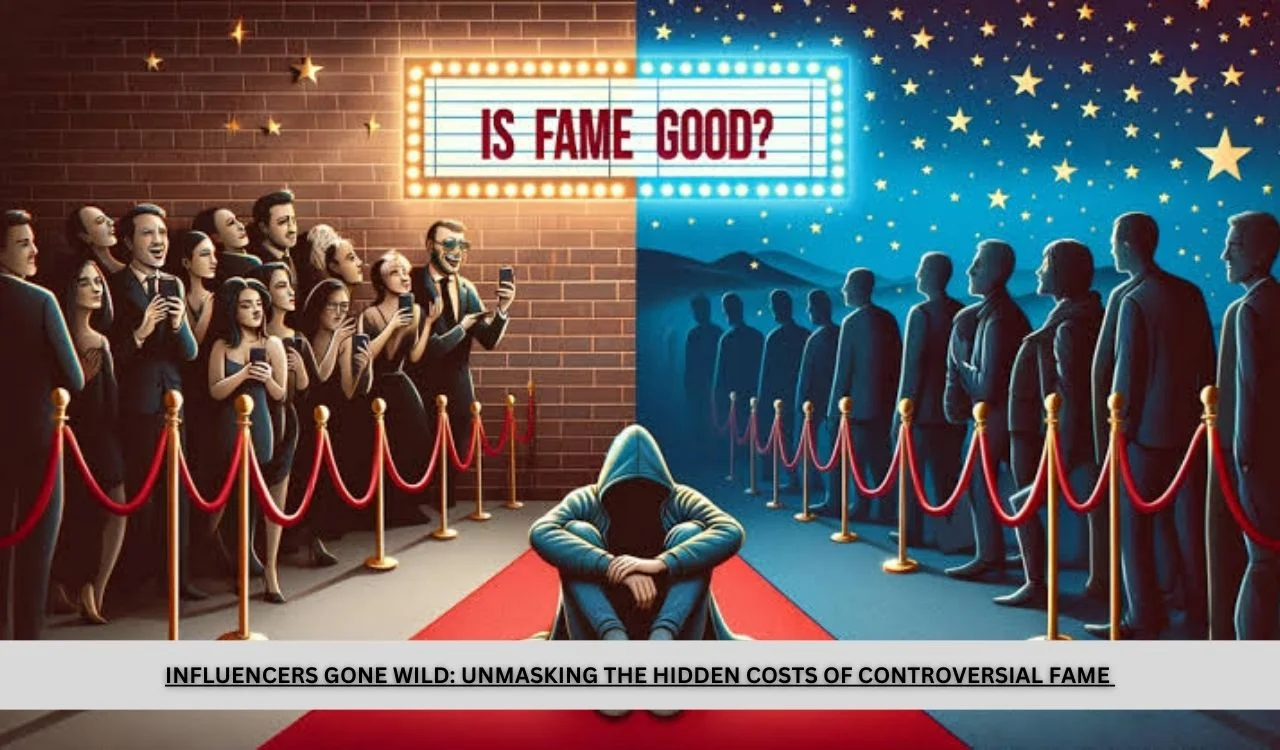The rise of social media has given birth to a new breed of celebrity—the influencer (Influencers Gone Wild). With their ability to connect directly with audiences, shape trends, and drive consumer behavior, influencers have become powerful figures in the digital landscape. However, beneath the glamorous exterior of viral videos and lucrative brand deals lies a more complicated reality. A subset of influencers, often labeled as “wild influencers (Influencers Gone Wild),” have gained notoriety for their controversial behavior, sensational content, and boundary-pushing antics in a bid to remain in the public eye.
This relentless pursuit of fame comes with consequences, both for the influencers themselves and the society that consumes their content. In this article, we delve into the rise of influencer culture, explore the dark side of wild influencers (Influencers Gone Wild), analyze the social implications of their content, and discuss how brands can navigate these turbulent waters by aligning with the right influencers.
The Heartbreak Behind Influencers Gone Wild: A Tale of Online Stardom
The phenomenon of social media influencers has become an inseparable part of the digital landscape. While many influencers have gained fame by sharing lifestyle tips, travel experiences, or beauty tutorials, others have taken a different route—pushing boundaries and engaging in controversial behavior to maintain relevance. The rise of these “wild influencers” (Influencers Gone Wild) is a double-edged sword, providing entertainment while also posing ethical and social questions. This article explores the rise of influencer culture, the dark side of Influencers Gone Wild, the social implications of their content, and how brands can choose the right influencers for their identity.
The Rise of Influencer Culture
The world of emerged with the advent of social media platforms such as Instagram, YouTube, and TikTok. Unlike traditional celebrities, who rely on film, TV, or music to reach their audience build their followings by sharing content directly on social media. These platforms have democratized fame, allowing everyday people to gain celebrity status through consistency, creativity, and connection with their followers.
The Evolution of Influencer Marketing
Influencer marketing began as a grassroots movement, where early social media adopters shared their genuine opinions and personal experiences. Over time, brands saw the potential of these to reach highly engaged, niche audiences and began investing heavily in influencer partnerships. From fashion and beauty to fitness and technology, nearly every industry has embraced influencer marketing as a way to reach target customers authentically.
The rise of influencers has been fueled by a variety of factors:
- Accessibility: Social media platforms are free and accessible to nearly everyone with an internet connection, making them ideal breeding grounds for influencers.
- Authenticity: Unlike celebrities are often seen as more relatable and authentic because they share glimpses of their everyday lives.
- Engagement: Influencers interact directly with their followers through comments, likes, and DMs, creating a sense of community and trust.
- Monetization Opportunities: With brand collaborations, sponsored posts, affiliate marketing, and merchandise sales have found numerous ways to turn their social presence into a profitable business.
Read Also: Doublelist: Unlocking the Potential

From Niche Creators to Mega Stars
As influencer culture has evolved, so have the influencers themselves. What started as niche content creators sharing personal passions has now grown into a full-fledged industry with mega stars boasting millions of followers. The competition for attention is fierce, and standing out often requires more than just high-quality content—it demands something unique, controversial, or even outrageous.
Exploring the Dark Side of Influencers Gone Wild
While many influencers have risen to fame with genuine content and positive engagement, a subset of them has taken a more reckless approach. These “wild influencers” called (Influencers Gone Wild) have made their mark by pushing boundaries, engaging in controversial behavior, and creating sensational content to maintain their status and followers. The constant need to be in the spotlight can sometimes drive them to extreme lengths, raising questions about ethics, mental health, and the potential harm to their audiences.
From Stardom to Controversy: The TikTok Influence
TikTok, the short-form video platform, has become a hotspot for who thrive on controversy. The platform’s algorithm heavily favors viral content, which often includes shocking, provocative, or downright dangerous videos. Many influencers on TikTok have resorted to creating content that flirts with or outright crosses ethical lines, including:
- Dangerous Challenges: Participating in and promoting challenges that could cause harm, such as the “Skull Breaker Challenge” or “Benadryl Challenge.”
- Misinformation: Spreading false or misleading information, especially about sensitive topics like health, politics, or social issues.
- Exploitation: Exploiting personal relationships, scandals, or sensitive topics for clicks and views, often without considering the emotional or psychological impact on those involved.
These actions can lead to significant backlash from the public, legal repercussions, and a loss of trust from their followers. However, the negative attention often fuels their popularity even more, creating a vicious cycle where controversy becomes currency.
Embracing Fame: The Influencers Gone Wild Journey
The path of a Influencers Gone Wild often starts innocently enough. Many begin by creating content that aligns with their personalities or interests. But as they gain more followers, the pressure to continuously outdo themselves grows. The desire to remain relevant in an oversaturated market can lead them to create content that is increasingly sensationalist, controversial, or dangerous.
Influencers Gone Wild often display a pattern of behavior that includes:
- Boundary Pushing: Constantly testing the limits of what is acceptable to attract more views.
- Attention Seeking: Creating content designed specifically to generate strong reactions, whether positive or negative.
- Burnout and Mental Health Issues: The relentless pursuit of fame and relevance can take a severe toll on an influencer’s mental health, leading to anxiety, depression, and burnout.
Influencers as Role Models: Navigating the Wild Side
Influencers, regardless of their style or approach, wield a considerable amount of influence, especially over younger audiences. As such, they have an inherent responsibility to act as role models, whether they choose to embrace it or not. Influencers Gone Wild, in particular, face criticism for promoting behavior that can be harmful or irresponsible.
Some of the potential negative impacts include:
- Normalization of Risky Behavior: Younger followers may mimic dangerous stunts or challenges without understanding the real-life consequences.
- Distorted Perceptions of Reality: Followers may develop unrealistic expectations about life, success, or beauty, influenced by highly curated or exaggerated content.
- Moral and Ethical Dilemmas: The lines between right and wrong can become blurred when controversy is constantly rewarded with attention and engagement.
Read Also: now.gg Roblox: Unlock the Future of Gaming

Wild Content and Its Social Implications
The rise of wild influencers (Influencers Gone Wild) and their sensational content has broader social implications that extend beyond the influencer space itself. As more influencers push boundaries to gain attention, society is grappling with the changing dynamics of online content, ethics, and behavior.
The Heartbreak of Influencers Gone Wild
Many influencers who go down the wild (Influencers Gone Wild) route often face a heartbreaking realization—their fame and fortune come at a steep cost. While the controversy may bring them short-term fame, the long-term consequences can be damaging:
- Loss of Credibility: Controversial behavior can result in a loss of credibility among followers and potential brand partners.
- Damaged Relationships: Personal relationships can suffer under the strain of constantly being in the public eye or being used for content.
- Legal Troubles: Some wild stunts or misinformation can lead to lawsuits, fines, or other legal consequences.
- Mental Health Decline: The constant pressure to perform, combined with backlash and criticism, can lead to significant mental health struggles.
This heartbreak is not just a personal experience; it is often played out publicly, with fans and followers witnessing the downfall of their once-beloved influencer.
Choosing the Right Influencers: Aligning with Your Cigar Shop’s Identity
For brands, particularly niche markets like cigar shops, choosing the right influencers to partner with is crucial for maintaining brand integrity and reaching the right audience. The choice of influencer can either enhance the brand’s image or risk damaging its reputation.
Factors to Consider When Choosing Influencers
When selecting influencers to collaborate with, it’s important to evaluate several key factors:
- Content Relevance: Does the influencer’s content align with your brand’s values and identity? For a cigar shop, an influencer who appreciates the craftsmanship and culture of cigars would be a better fit than one focused on shock value.
- Audience Demographics: Ensure that the influencer’s audience matches your target demographic. An influencer with a young, health-conscious following may not be the best match for promoting cigars.
- Engagement Quality: Look beyond the number of followers. Consider the quality of their engagement. Do their followers interact meaningfully with their content, or is it filled with generic comments and spam?
- Reputation and Past Behavior: An influencer’s past controversies or reputation can reflect on your brand. It’s essential to do thorough research to avoid potential PR disasters.
Building Long-Term Relationships with Influencers
Instead of opting for a one-off campaign, building long-term partnerships with influencers can create more authentic and meaningful connections with your audience. Influencers who are genuinely passionate about your products or brand will naturally create more engaging and authentic content, resulting in higher trust and credibility.
Influencers’ Responsibility to Followers
Influencers, by the very nature of their role, hold significant power over their followers, particularly younger and more impressionable audiences. This influence comes with a responsibility to act ethically and consider the potential impact of their content. The rapid spread of misinformation, promotion of risky behaviors, and glorification of unattainable lifestyles can have detrimental effects on followers, leading to negative social, psychological, and even physical consequences.
The responsibility of influencers extends beyond simply creating engaging content. They should be aware of the messages they send and the behaviors they endorse, consciously choosing to promote values like authenticity, mental health awareness, and positive social behavior. By using their platforms to raise awareness on important issues and advocate for constructive change, influencers can help foster a healthier and more supportive online community. Ultimately, the most respected and enduring influencers are those who prioritize their followers’ well-being over sensationalism.
Industry Standards and Guidelines
As the influencer marketing industry grows, so does the need for clearer standards and guidelines to ensure ethical behavior. Regulatory bodies and social media platforms have started implementing policies to protect users from harmful content and ensure transparency in sponsored posts and partnerships. For example, guidelines from organizations like the Federal Trade Commission (FTC) in the United States and the Advertising Standards Authority (ASA) in the UK require influencers to disclose paid promotions, helping maintain honesty and trust with their audience.
However, these guidelines are often not strictly enforced, and many influencers still operate in a grey area, exploiting loopholes or taking risks to stand out. The lack of a universal standard makes it difficult for both influencers and brands to navigate ethical boundaries consistently. Strengthening industry-wide standards and encouraging influencers to self-regulate and adhere to ethical guidelines is crucial for the growth and sustainability of the influencer ecosystem.
Regional Differences in Influencer Behavior
Influencer behavior can vary significantly across different regions, reflecting cultural norms, societal values, and regional regulations. In some countries, influencers may face stricter legal constraints on the type of content they produce or promote, particularly regarding sensitive topics like health, politics, or social issues. For example:
- United States and Europe: There is a greater emphasis on transparency and honesty in influencer marketing, driven by stringent regulations from bodies like the FTC and ASA.
- Asia: In countries like China and South Korea, influencers often focus on promoting aspirational lifestyles and beauty standards, sometimes resulting in criticism for promoting unrealistic ideals.
- Middle East: Influencers must navigate cultural and religious sensitivities, often avoiding controversial topics that could result in legal consequences or public backlash.
Understanding these regional differences is essential for global brands looking to partner with influencers, as it affects how they craft their campaigns and choose suitable collaborators.
Final Thoughts on the Influencers Gone Wild
The rise of wild influencers (Influencers Gone Wild) and the sensationalist content they produce has undoubtedly changed the landscape of social media and digital marketing. While such content may bring short-term fame and engagement, it often comes at a cost—to the influencers’ mental health, their followers’ well-being, and society’s ethical standards. The responsibility lies not only with influencers but also with brands, platforms, and audiences to promote more meaningful and responsible online behavior.
As the digital world continues to evolve, the key to sustainable influence lies in authenticity, accountability, and alignment with positive values. By encouraging ethical practices and holding influencers accountable for their actions, we can help ensure that the digital landscape remains a space for positive influence, creativity, and constructive engagement.
Read Also: Infinite Craft: Unleash Your Creativity, The Ultimate Guide to Mastering

Conclusion
The world of influencers is vast and varied, ranging from creators who build their brands on authenticity and positive engagement to those who thrive on controversy and shock value. While the appeal of wild influencers (Influencers Gone Wild) and their sensational content is undeniable, it is essential to consider the broader social and ethical implications of their actions. The constant drive for virality and relevance can lead to risky behaviors, misinformation, and mental health struggles, not only for the influencers themselves but also for their impressionable audiences.
For brands looking to partner with influencers, aligning with those who share their values and resonate with their target market is crucial for maintaining credibility and trust. As influencer culture continues to evolve, both brands and audiences must prioritize responsible and meaningful engagement, ensuring that the digital world remains a space for positive influence and authentic connection.
